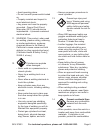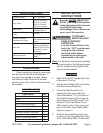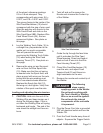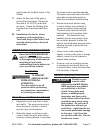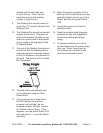Page 7SKU 97503 For technical questions, please call 1-800-444-3353.
with a cover made of re resistant
material.
Remove or make safe all •
combustible materials for a radius
of 35 feet (10 meters) around the
work area. Use a re resistant
material to cover or block all open
doorways, windows, cracks, and
other openings.
Enclose the work area with portable •
re resistant screens. Protect
combustible walls, ceilings, oors,
etc., from sparks and heat with re
resistant covers.
If working on a metal wall, •
ceiling, etc., prevent ignition of
combustibles on the other side
by moving the combustibles to
a safe location. If relocation of
combustibles is not possible,
designate someone to serve as
a re watch, equipped with a re
extinguisher, during the cutting
process and for at least one half
hour after the cutting is completed.
Do not weld or cut materials •
having a combustible coating or
combustible internal structure,
as in walls or ceilings, without an
approved method for eliminating the
hazard.
Do not dispose of hot slag in •
containers holding combustible
materials. Keep a re extinguisher
nearby and know how to use it.
After spot welding, make a •
thorough examination for evidence
of re. Be aware that easily-
visible smoke or ame may not
be present for some time after
the re has started. Do not weld
or cut in atmospheres containing
dangerously reactive or ammable
gases, vapors, liquids, and dust.
Provide adequate ventilation in
work areas to prevent accumulation
of ammable gases, vapors, and
dust. Do not apply heat to a
container that has held an unknown
substance or a combustible
material whose contents, when
heated, can produce ammable or
explosive vapors. Clean and purge
containers before applying heat.
Vent closed containers, including
castings, before preheating,
welding, or cutting.
Do not touch live electrical parts. 15.
Wear dry, insulating gloves. Do not
touch electrode or conductor tong
with bare hand. Do not wear wet or
damaged gloves.
Protect yourself from electric shock. 16.
Do not use outdoors. Insulate
yourself from the work piece and
ground. Use nonammable, dry
insulating material if possible, or
use dry rubber mats, dry wood or
plywood, or other dry insulating
material big enough to cover your
full area of contact with the work or
ground.
Ensure that the unit is placed on a 17.
stable location before use. If this unit
falls while plugged in, severe injury,
electric shock, or re may result.
Ground this product. This Welder 18.
requires the attachment and use of a
UL-listed, 240 volt grounded, 3-prong,
electrical Power Cord Plug (not
included). Only a quali ed electrician
should install the Power Cord Plug.
Never remove the grounding prong
or modify the Power Cord Plug in any








